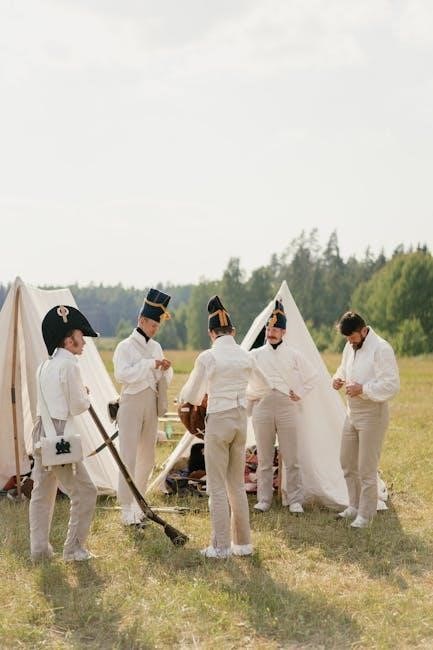This hymn, sung by military chaplains and aviators, reflects a deep trust in divine protection, offering solace and strength to those navigating the dangers of aviation․
Overview of the Hymn’s Purpose and Significance
The hymn “Lord, Guard and Guide the Men Who Fly” serves as a heartfelt prayer for the safety and protection of aviators and service members․ Its purpose is to provide comfort and reassurance to those facing the risks of flight and military duty․ The hymn emphasizes trust in divine guidance, seeking God’s watchful care over those in perilous situations․ It has become a significant part of military and aviation traditions, offering solace to pilots, crew, and their families․ The hymn’s significance lies in its timeless message of faith and reliance on a higher power, resonating with audiences across generations and circumstances․ Its enduring relevance underscores the universal human need for strength and protection in times of uncertainty and danger․
The Historical Context of the Hymn
The hymn “Lord, Guard and Guide the Men Who Fly” emerged during a time of heightened aviation activity, particularly influenced by World War II․ It was written to address the growing need for spiritual support among pilots and aircrew facing immense risks․ The hymn draws inspiration from earlier maritime hymns, adapting their themes of divine protection to the skies․ Its creation coincided with the expansion of air forces and the increasing reliance on aviation in military operations․ Over time, it became a staple in military chapels and aviation ceremonies, reflecting the evolving role of air power in global conflicts․ The hymn’s historical roots are deeply intertwined with the experiences of service members and the technological advancements of flight․
Its Role in Aviation and Military Traditions
The hymn “Lord, Guard and Guide the Men Who Fly” holds a revered place in aviation and military traditions, serving as a source of comfort and strength for pilots and crew․ It is often sung during ceremonies, memorials, and special events honoring aviators․ The hymn has become a tradition within military chapels and air force communities, symbolizing faith, protection, and divine guidance․ Its adaptation from maritime hymns reflects the evolution of military operations into the skies․ Today, it remains a powerful symbol of resilience and trust in God’s providence, fostering a sense of camaraderie and shared purpose among service members․ Its enduring presence underscores the deep spiritual connection within aviation and military culture․

The Origins and Evolution of the Hymn
The hymn originated from maritime traditions, later adapted for aviation, reflecting its enduring relevance in seeking divine protection across different eras and domains of service․
The Author and Composer Behind the Hymn
The hymn “Lord, Guard and Guide the Men Who Fly” is an adaptation of the traditional maritime hymn “Eternal Father, Strong to Save,” written by William Whiting in 1846․ Its melody, composed by John Bacchus Dykes in 1861, has been repurposed for aviation․ While the original hymn was dedicated to sailors, the aviation version emerged during World War II, reflecting the growing role of airpower․ The specific author of the aviation adaptation remains unclear, but it is often attributed to military chaplains who sought to inspire and comfort airmen․ The hymn’s evolution mirrors the shift from sea to air dominance, making it a cherished piece in military and aviation traditions․ Its enduring popularity lies in its ability to resonate with those seeking divine protection in perilous skies․
How the Hymn Was Adapted for Aviation
The hymn “Lord, Guard and Guide the Men Who Fly” was adapted from the traditional maritime hymn “Eternal Father, Strong to Save,” originally written for sailors․ To suit aviation, lyrics were modified to reflect the dangers and challenges of flight․ Phrases like “who through the great spaces in the sky” replaced nautical references, emphasizing the vastness and risks of aviation․ This adaptation emerged during World War II, as airpower became central to military operations․ The hymn’s message of divine protection resonated deeply with pilots and crew, offering comfort and strength during perilous missions․ Its transformation from a sea-faring hymn to an aviation anthem highlights its versatility and relevance in times of change and innovation․
Key Lyrics and Their Meanings
The hymn “Lord, Guard and Guide the Men Who Fly” features poignant lyrics that reflect the challenges and dangers of aviation․ The opening lines, “Lord, guard and guide the men who fly,” serve as a direct prayer for divine protection․ The verse “Through the great spaces in the sky” emphasizes the vastness and unpredictability of the aviator’s environment․ Another line, “Be with them always in the air, on land, on sea,” underscores the need for constant vigilance and care․ The hymn also expresses trust in God’s providence, with phrases like “In every test, in every flight” highlighting reliance on faith during critical moments․ These lyrics resonate deeply with pilots and crew, offering comfort and strength in the face of adversity․ The hymn’s words are both a prayer and a statement of unwavering faith․

Religious and Spiritual Themes in the Hymn
The hymn is a heartfelt prayer for divine protection, emphasizing trust in God’s providence․ It reflects themes of faith, divine guidance, and prayer as a source of strength․
The Concept of Divine Guidance in Times of Danger
The hymn captures the belief in divine guidance as a source of comfort during perilous aviation missions․ It reflects the trust that God’s presence offers protection and direction, even in the most uncertain and dangerous situations․ By invoking divine guidance, the hymn emphasizes reliance on a higher power to navigate challenges․ This theme resonates deeply with pilots and crew, who often face life-threatening risks․ The lyrics illustrate how faith can provide steadfast reassurance, transforming fear into courage and uncertainty into hope․ Through its verses, the hymn underscores the enduring belief in divine providence, offering solace and strength to those who venture into the skies․

The Role of Faith in the Lives of Pilots and Crew
Faith plays a vital role in the lives of pilots and crew, serving as a moral compass and source of resilience․ The hymn reflects this by emphasizing trust in divine protection, offering comfort during high-stakes missions․ For many aviators, faith is not just a personal belief but a shared experience that fosters camaraderie and mutual support․ It provides a spiritual anchor, helping them navigate the psychological and emotional challenges of their profession․ Pilots often rely on faith to make split-second decisions and cope with the uncertainties of flight․ This deep-seated belief is celebrated in the hymn, which has become a tradition in aviation and military circles, resonating with those who face danger and rely on faith for strength and clarity․
Prayer as a Source of Strength and Protection
Prayer serves as a lifeline for those in aviation, offering solace and fortitude in moments of uncertainty․ The hymn underscores this by seeking divine guardianship, reflecting the deep reliance on prayer for safety and clarity․ Pilots and crew often turn to prayer as a means of finding peace amidst the dangers of flight․ It provides reassurance, helping them stay focused and composed under pressure․ Prayer also fosters a sense of unity among the team, creating a shared spiritual bond․ This tradition of seeking divine protection is deeply rooted in military and aviation cultures, where prayer is not just a personal act but a collective practice that strengthens resolve and provides hope․ Through prayer, aviators find the courage to face challenges, trusting in a higher power for guidance and protection․
Biblical References and Inspirations
The hymn “Lord, Guard and Guide the Men Who Fly” draws inspiration from biblical themes of divine protection and trust in God․ Its lyrics echo passages like Psalm 91, which speaks of God as a refuge and shield․ The hymn’s plea for guidance reflects Proverbs 3:5-6, urging trust in the Lord․ Its message of faith aligns with John 3:16, emphasizing God’s love and provision․ The hymn also mirrors the prayerful spirit of Ephesians 6:18, encouraging believers to pray for strength․ By invoking these scriptural ideals, the hymn serves as a powerful bridge between aviation’s challenges and timeless biblical truths, offering comfort and assurance to those seeking divine support in their journeys․ Its verses resonate deeply with those who find solace in faith during uncertain times․

Personal Reflections and Stories

Many chaplains and aviators share stories of finding comfort in the hymn during challenging missions․ It has been a source of strength, especially during funerals or difficult flights, inspiring trust in divine guidance and protection․
Testimonies from Pilots Who Found Comfort in the Hymn

Chaplains and pilots have shared heartfelt stories of how the hymn brought solace during intense missions․ One chaplain recalled singing it at a pilot’s funeral, finding comfort in its words․ Aviators often mention that the hymn’s message of divine guidance helped them stay calm during emergencies․ Many have expressed how the hymn reinforced their faith, providing a sense of protection․ Its melody and lyrics have become a source of strength, reminding them of God’s presence in the skies․ These testimonies highlight the hymn’s enduring impact on those who face danger daily, offering hope and reassurance in critical moments․ Its influence extends beyond the cockpit, touching families and loved ones as well․
How the Hymn Has Inspired Those in Aviation

The hymn has deeply inspired aviators, fostering a sense of divine connection and purpose․ Many pilots have credited the hymn with strengthening their resolve during challenging flights․ Its message of protection and guidance has motivated aviators to embrace their roles with renewed faith․ The hymn has also inspired the creation of aviation-themed ceremonies and rituals, where it is often sung to honor those who serve․ Its influence extends to younger generations, encouraging them to pursue careers in aviation with a sense of higher calling; The hymn’s timeless appeal continues to resonate, reminding all who hear it of the importance of trust and faith in times of uncertainty․ Its impact on aviation culture remains profound and enduring․
Personal Experiences of Finding Guidance Through Prayer
Many individuals have shared personal stories of finding guidance through prayer while reflecting on the hymn․ Pilots and crew members often recount moments of intense uncertainty, where the hymn’s words became a source of comfort․ One pilot shared how, during a harrowing storm, repeating the hymn brought clarity and focus․ Another recalled feeling an unexplainable sense of calm during an emergency landing, attributing it to the divine guidance invoked in the hymn․ These experiences highlight the profound impact of prayer in times of crisis, mirroring the hymn’s theme of trust in a higher power․ Such stories underscore the enduring relevance of faith in aviation, offering hope and resilience to those who face perilous skies․
The Hymn’s Impact on Families of Service Members

The hymn has profoundly touched the families of service members, offering solace during times of separation and uncertainty․ Many have found comfort in its words, which remind them of God’s protective hand over their loved ones․ Families often express how the hymn alleviates anxiety, providing a sense of reassurance․ The hymn’s emphasis on divine guidance resonates deeply, especially when loved ones are deployed or engaged in high-risk missions․ It serves as a spiritual anchor, fostering hope and resilience․ Through shared singing or personal reflection, the hymn strengthens familial bonds and reinforces trust in a higher power, becoming a cherished part of their support system․ Its message transcends individual prayer, embracing entire families in a shared experience of faith and protection․

The Hymn’s Relevance in Modern Times
The hymn remains deeply relevant today, offering timeless themes of protection and guidance․ Its message continues to resonate with modern audiences, inspiring faith and hope in challenging times․
How the Hymn Resonates with Contemporary Audiences
The hymn “Lord, Guard and Guide the Men Who Fly” continues to resonate deeply with modern audiences, particularly within military and aviation communities․ Its themes of divine protection and guidance speak to the universal human desire for safety and reassurance in uncertain and dangerous professions․ The hymn’s message transcends time, offering comfort to pilots, service members, and their families facing contemporary challenges․ Its adaptation to modern military and aviation ceremonies underscores its enduring relevance․ The hymn’s emphasis on faith and prayer as sources of strength aligns with the personal and spiritual needs of many today․ As a result, it remains a powerful and inspiring anthem, bridging the gap between tradition and modern life, while fostering a sense of hope and resilience in the face of adversity․
Its Use in Modern Military and Aviation Ceremonies
The hymn “Lord, Guard and Guide the Men Who Fly” remains a cherished element in modern military and aviation ceremonies․ It is frequently performed during graduation ceremonies for pilots, memorials honoring fallen aviators, and promotional events within the armed forces․ The hymn’s powerful lyrics and soaring melody evoke a sense of pride, unity, and divine connection among service members and their families․ Many military chaplains incorporate it into services to provide spiritual comfort and reinforce the bond between faith and service․ Its continued use underscores its relevance in contemporary contexts, where the risks and challenges of aviation and military life remain ever-present․ The hymn serves as a timeless reminder of trust in a higher power, resonating deeply with modern audiences seeking solace and inspiration․
The Timeless Message of Protection and Guidance
The hymn “Lord, Guard and Guide the Men Who Fly” embodies a timeless message of divine protection and guidance, resonating deeply with those who face danger in the skies․ Its heartfelt prayer seeks God’s watchful care over aviators, reflecting a profound trust in His sovereignty․ The hymn’s enduring appeal lies in its universal themes of safety, courage, and reliance on a higher power․ It continues to inspire faith and hope, offering comfort to both service members and their families․ By emphasizing the need for divine protection, the hymn transcends generations, remaining a powerful expression of trust in God’s providence․ Its message is as relevant today as it was when first composed, uplifting all who seek strength in times of uncertainty․
The hymn “Lord, Guard and Guide the Men Who Fly” stands as a testament to faith and resilience, offering timeless solace to aviators and beyond, inspiring trust in God’s guidance and protection across generations․
Final Thoughts on the Hymn’s Legacy
The hymn “Lord, Guard and Guide the Men Who Fly” leaves a profound legacy, transcending aviation to inspire faith and courage in all who seek divine guidance․ Its timeless message of trust in God’s protection resonates deeply, adapting across generations to remain relevant․ The hymn’s enduring influence is evident in its continued use in military and aviation ceremonies, as well as its role in personal reflections․ It serves as a powerful reminder of the importance of faith in overcoming uncertainty and danger․ Through its verses, the hymn has become a source of comfort and strength, not only for pilots but for anyone facing life’s challenges․ Its legacy endures as a testament to the human spirit’s ability to find solace in prayer and divine guidance․
Its Enduring Influence on Faith and Aviation
The hymn “Lord, Guard and Guide the Men Who Fly” continues to inspire both faith and aviation communities, bridging the gap between spiritual devotion and professional dedication․ Its adaptation from the traditional tune of “Eternal Father, Strong to Save” highlights its timeless appeal․ Pilots and crew members often find solace in its words, which evoke divine protection and guidance during perilous flights․ The hymn’s influence extends beyond aviation, resonating with anyone seeking comfort in times of uncertainty․ Its enduring legacy lies in its ability to strengthen faith while honoring the bravery of those who take to the skies․ This balance of spirituality and practical application ensures its relevance in modern aviation and military traditions, making it a cherished hymn for generations․

